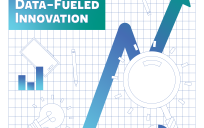This interview is an excerpt from GovLoop’s recent guide, What the Internet of Things Means for the Public Sector, which explores insights and best practices into how government is using automated machine-to-machine transactions and implementing IoT in the public sector.
We live in a complex world. With millions of new devices and applications being produced every day, the sheer volume of data produced by Internet of Things can make it even more complex.
But it doesn’t have to be that way. GovLoop sat down with Michelle Davis, Senior Solution Architect at Red Hat, to discuss how open source software helps organizations optimize data produced by the Internet of Things to align IT strategies with business goals.
Today, Davis said, “organizations have a wealth of information at their disposal to help them make data-driven decisions. Sensors on billions of devices around the world disseminate information that enterprises collect to help make better services and smarter decisions. For the data produced by these devices to be useful, agencies must compare new information with existing data from traditional sources. The large influx of information from IoT devices presents serious aggregation, ingestion and analytical challenges for both government agencies and IT organizations.”
For many organizations, there is no standard way of integrating this information. Red Hat wants to change that. They believe there should be a flexible, inexpensive standards-based solution for IoT data that would reduce risk and support a variety of environments.
“Open source is one of the drivers for the Internet of Things because it allows people to rapidly create new innovations,” Davis explained. As an enterprise open source software company, Red Hat offers solutions with essential tools to tackle the staggering amount of IoT data.
Driven by a passion for innovation and open source software, and a desire to help enterprises create applications faster in a smarter way, Red Hat offers their JBoss Middleware portfolio. “JBoss Middleware is a family of enterprise-class, cloud friendly integration and middleware products that one would use to build, create, connect, deploy and run intelligent applications.” Davis said. This middleware provides tools to embrace and include IoT.
Red Hat JBoss Fuse allows organizations to create and deploy integrated applications, utilizing standards, which ultimately improves portability and reduces time to market while removing risk. Giving developers the flexibility that they need to build new applications, Red Hat JBoss Data Virtualization is providing government agencies and private organizations a unique solution that effectively marries new information with existing infrastructures. Across the country, organizations are using Red Hat’s JBoss Middleware portfolio to build scalable, secure solutions to aggregate, ingest, transform and analyze IoT data.
An example? Following several demands for better train safety, Meteorcomm, the leader in data communications infrastructure solutions for the railroad industry, worked with Red Hat to implement a sensor-based solution to address this problem. Armed with a new network of interconnected devices, these sensors use automated communication to ensure that trains maintain safety and efficiency.
In the near future, Red Hat expects most agencies will be incorporating smart devices and sensors to improve quality of services such as border patrol cargo inspections, or veterans’ medical visits by automatically linking patient’s electronic health records with biomedical research databases. Innovations like these would significantly improve border inspector’s productivity to secure our border and healthcare providers’ ability to treat veterans quickly and effectively. By collecting and integrating isolated data, Red Hat helps government agencies become more innovative and efficient.
For government agencies, security is one of the biggest challenges in the world of the Internet of Things. “The ability to move this information back and forth securely is necessary,” Davis said. JBoss Fuse provides encryption, authorization and identification with different IoT protocols like MQTT, STOMP or AMQP to securely move IoT data from one network to another.
With JBoss Fuse, agencies can ingest IoT data in a secure, scalable manner. JBoss Fuse is a lightweight integration platform that can connect any application, data or device. The JBoss Data Virtualization software then lets agencies analyze this new data alongside traditional data. With this analysis, government organizations are able to make better decisions and improve their services to citizens. Red Hat’s IoT reach goes beyond middleware as the need for smarter storage or an on-premise cloud-like scaling platform increases.
The sheer volume of new information being generated by the Internet of Things presents challenges and opportunities for both the public and private sector, Davis said. This information, which years ago would have been considered isolated, will allow a new collaboration between government and industry and citizens. This creates whole new categories of information gathered, and opportunities to use devices to more effectively manipulate objects. These in turn gives rise to new opportunities for the government to share information, innovate, save lives, make more informed decisions, and actually extend the scope of machine and human impact.
Red Hat’s JBoss Middleware portfolio has made the complex world of IoT easier for government to navigate. With secure and accessible information, the government’s way of doing business is becoming more efficient and data driven, changing the lives of citizens for the better.
Photo Credit: Flickr/thinkpanama





Leave a Reply
You must be logged in to post a comment.